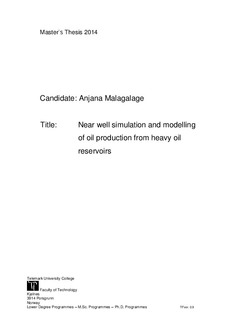Near well simulation and modelling of oil production from heavy oil reservoirs
Master thesis
Published version
Permanent lenke
http://hdl.handle.net/11250/2439017Utgivelsesdato
2015-10-30Metadata
Vis full innførselSamlinger
Originalversjon
Malagalage, A Near well simulation and modelling of oil production from heavy oil reservoirs. Master thesis, Telemark University College, 2014Sammendrag
Heavy oil reservoirs cover up two third of the world's hydrocarbon reservoirs. Even though they are a vast energy reserve, heavy oil recovery is not considered economical due to its high viscous property. Generally horizontal wells are more suitable for heavy oil recovery. When the heavy oil is produced with water drive, a water breakthrough is expected in high permeable zones of the reservoir or in the heel of the well. Once water has started to be produced, heavy oil reservoirs tend to produce more water than oil. In order to overcome this issue, inflow control devices are being used. Conventional inflow control devices are only capable in in delaying a water breakthrough. The disadvantage of ICDs is that, it cannot control the water inflow, after water breakthrough has occurred. Autonomous inflow control valve (AICV) is designed to choke the inflow as soon as the water breakthrough has occurred. In order to evaluate the performance of AICVs in different reservoir types, OLGA-Rocx simulation system was used. As the different types of wells, fractured, heterogeneous and homogeneous reservoirs were selected. By comparing the obtained results with conventional ICDs it was found that the AICVs have a superior potential in limiting the water inflow to the base pipe (86% reduction in water accumulation compared to normal ICD in fractured reservoir). It was also observed that, AICV are more effective in heterogeneous, fractured reservoirs as it can restrict the early water breakthrough. Even in homogeneous reservoirs, AICVs have the capability in controlling the water inflow. As a result, oil production rate would also be reduced compared to the ICD system. It can be observed that when the minimum allowable flow through an AICV (when the AICV is in closed position) is increased both accumulated oil and water volumes increase. The reopening time of the AICV valve basically depends on the viscosity and the density of the considered oil. If the viscosity is high, the time taken to reopen the valve will be increased while it will be reduced by the high density fluid. As the permeability of the of the reservoir increases, reopening time of the valve will be reduced. The reopening time also depends on the outer and inner radius of the wellbore annulus. It will increase along with the increasing outer radius and will decrease along with the increasing inner radius.
